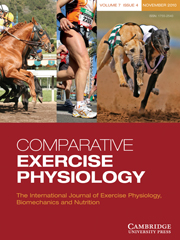This correspondence is in response to Dr. David C. Poole's concerns about the experimental design and data interpretation in our journal article published in January, 2009Reference Poole1, Reference Lamprecht, Bagnell and Williams2.
Control group and repeated sampling
The authors agree with Dr. Poole that including controls in making scientific comparisons is important. However, in this preliminary trial, a standing control group of horses was not included based on evidence in the literature that suggests repeated sampling of blood and synovial fluid, under similar conditions as reported here, does not introduce a confounding variableReference Brenner, Natale, Vasiliou, Moldoveanu, Shek and Shephard3–Reference Frisbie, Al-Sobayil, Billinghurst, Kawcak and McIlwraith6. As for repeated synovial fluid sampling, Fig. 3 in the original paper illustrates that there was no sampling effect in either joint samples. In a larger study completed after this pilot work, a non-exercise control group was included in measuring synovial fluid prostaglandin E2 concentrationsReference Lamprecht7. Results indicated no differences in synovial fluid PGE2 between sample times in the control group.
Plasma nitrite levels
Dr. Poole's point about nitrite variability in Fig. 2 of the original paper is well taken and we agree that PRE sample nitrite values are not the same across exercise protocols. However, this had no effect on the conclusions made since comparisons regarding differences in plasma nitrite concentrations were made relative to their own PRE sample concentrations.
Primary heart rate responses
Although we did not measure oxygen uptake in this study, Table 1 details the individual peak heart rates achieved during each of the exercise tests run during this pilot study: graded exercise test (GXT), interval exercise test (IET) and the repeated sprints exercise test (RSET). The authors regret that statistical analysis of data in Table 3 was not included in the manuscript. The statement in the abstract regarding an effect of exercise protocol on time spent at >90% HRmax is not justified.
Table 1 Peak heart rate (beats min-1)

Nitric oxide versus total nitrate terminology
The authors agree with Dr. Poole and never intended to imply that nitrite and nitric oxide (NO) were synonymous in their physiological roles. Since NO has a short half-life, its oxidation eventually results in the formation of nitrite and nitrate which are often quantified as indirect markers of NO productionReference Sastry, Moudgal, Mohan, Tyagi and Rao8, and thus nitrite was used as an indirect marker of NO levels in this paper.
Closing statement
The data presented in the study discussed herein, as with all other scientific studies, should be considered within the framework of the experimental design, the inherent limitations and original objectives stated by the primary investigator. The data and conclusions presented in the article at hand are certainly not indisputable or absolute but are intended to provide a relative framework within which to consider the effects of the different exercise efforts in a small group of unfit horses, and how they might be used as a reference or tool in light of other experimental conditions. The time and effort Dr. Poole spent evaluating this pilot study is very much appreciated.


